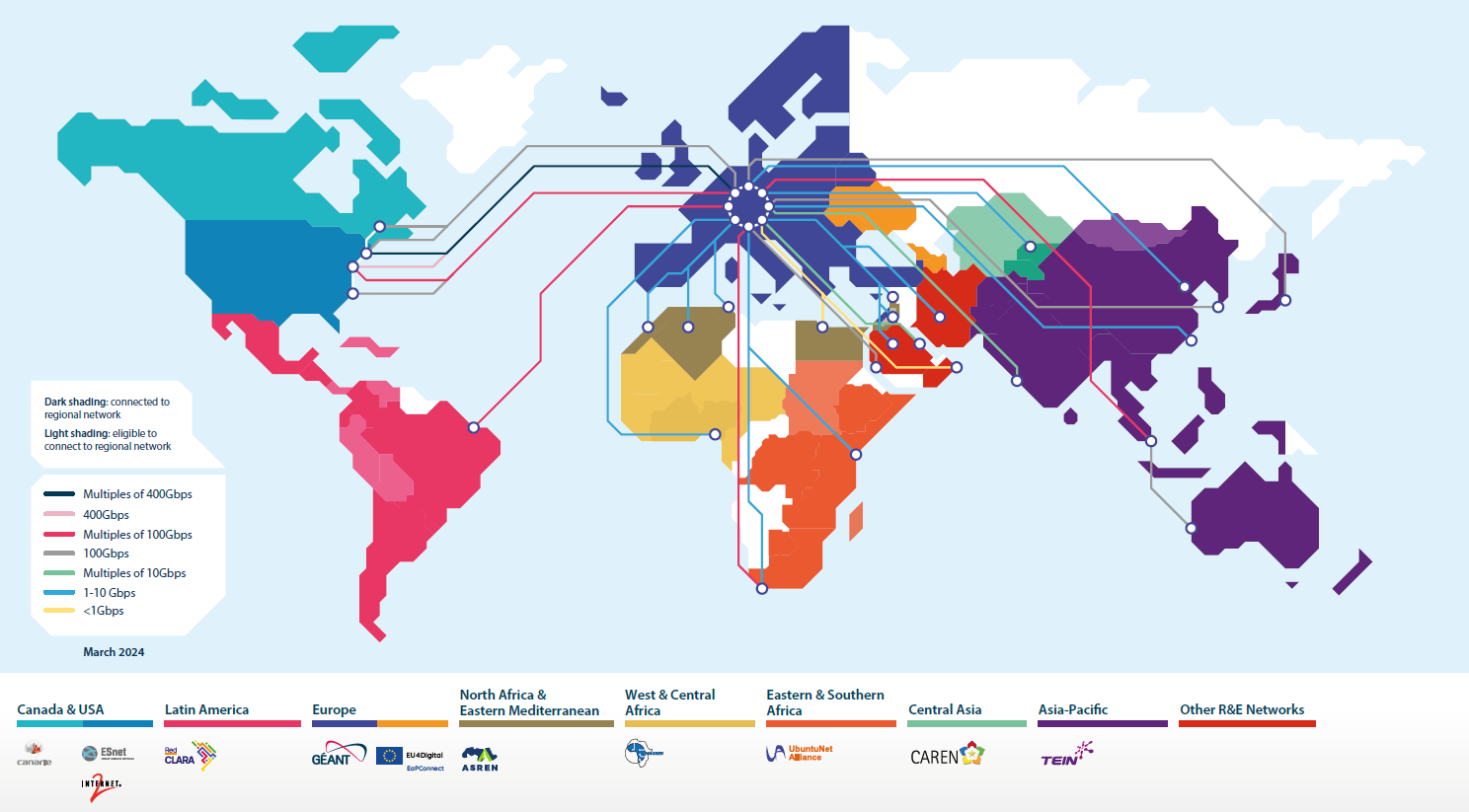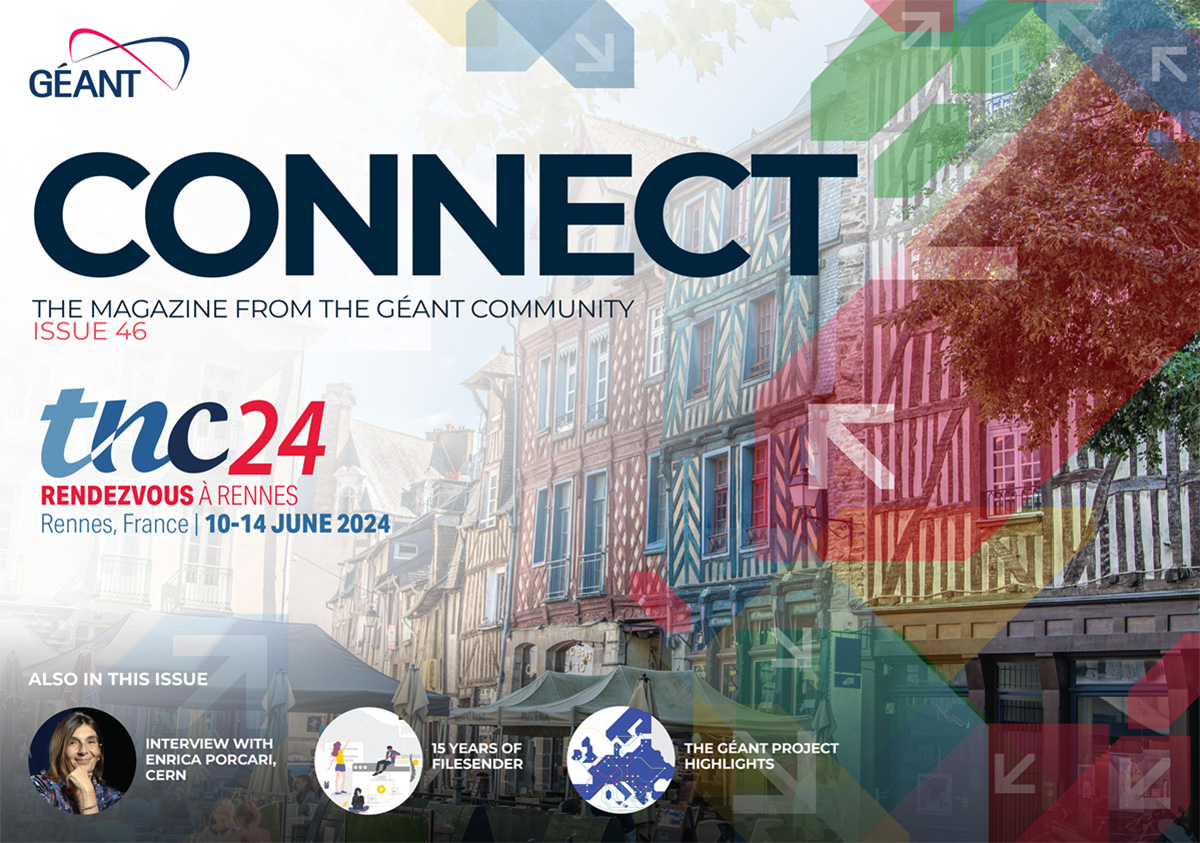The global connectivity landscape is undergoing significant transformations and becoming increasingly intricate [see the article “Five Hundred and Fifty Cables Under The Seas”, which also appeared on CONNECT46]. We spoke with GN5-IC1 coordinator Veronika Di Luna (GÉANT) to find out how the project is navigating this complex scenario and how it is helping GÉANT to define its intercontinental connectivity investments.

Veronika, why is GÉANT re-defining its intercontinental connectivity approach?
Currently, 25% of the traffic across the GÉANT Network backbone either originates from or is destined for locations outside of Europe, supporting global data-intensive research activities. Moreover, we forecast 30-35% growth year on year on GÉANT intercontinental traffic, due to big scientific projects such as the LHC and ITER significantly increasing data production, or as the SKA Observatory and the High-Luminosity LHC becoming operational. Interest in intercontinental investment is also shifting, due to a variety of factors: key submarine cables reaching their end of life, changes in the market, a stronger appetite for long-term stability, geopolitical tensions in crucial transit locations, a need for improved capacity and resilience beyond our European network.
From a policy standpoint, the European Commission revised its stance on the topic through the launch of the Global Gateway strategy [see again the article “Five Hundred and Fifty Cables Under The Seas”]. In this context and considering the sheer volume of intercontinental investment, it has become necessary for GÉANT to transition towards a more strategic and systematic approach.
How does this fit into past and ongoing GÉANT efforts?
GÉANT has already been moving for some time from a model based on short-term contracts towards mid- to long-term investments: in Europe through the GN4-3N project, and globally through projects like AfricaConnect, EaPConnect and – most prominently – the BELLA initiative. As a further step in this direction and building on these successful experiences, GÉANT is now participating in the MEDUSA Submarine Cable Project, the EC’s first digital Global Gateway aiming to connect North Africa and Europe.
Additionally, we are increasing our efforts to support the resilience and security of global submarine cable systems, and recently joined the International Cable Protection Committee (ICPC) as the first member organisation from the R&E networking community. GÉANT also continues to work to strengthen the global fabric of R&E networking, through intercontinental collaborations such as the Advanced North Atlantic (ANA) Consortium, the Asia-Pacific-Europe Ring (AER), the “Bridging Europe, Africa and the Americas” (BEAA) Collaboration, and participation in GNA-G, the Global Network Advancement Group.
What steps did GN5-IC1 take towards a new approach?
Our focus in the past year was on the definition of a series of pillars and guidelines, that would help us to identify the main reasons and areas for investments and support our intercontinental connectivity strategy. The project was well positioned to lay the groundwork for this activity, as the team combines the knowledge of the international landscape and of the user needs, strategic planning and network architecture expertise, as well as the market intelligence and procurement knowledge. Following the initial draft, we expanded the consultation to our community, to ensure the alignment of GÉANT’s investments with the GÉANT Association Strategy, with other ongoing activities, and with the needs and interests of both GÉANT and of its members, who are ultimately the ones benefitting from the investments and bearing their recurring costs. The process took about eight months and involved consultations with the NIAC (Network Infrastructure Advisory Committee), with the broader community and with the GÉANT Board.
Can you tell us more about the pillars and guidelines you identified? What’s their aim and what are the main differences between them?
Pillars and guidelines are not prescriptive. Both are primarily meant to be used as reference points, and as guidance to evaluate investments and present cases to the governance for approval. In particular, pillars are meant to outline the general direction and the reasons for our investments. Our approach is based on three pillars:
- Serving the needs of the European R&E Community. This ensures that our investments meet the global data communication needs of GÉANT Member RENs and their connected European big science infrastructure and collaborations.
- Global Collaboration. This pillar covers collaboration with other regions and focuses on the development of R&E Networking globally.
- European Autonomy. This is in many ways similar to the first pillar, however, we decided to keep it as a standalone item, as it goes beyond simple traffic forecasts and R&E requirements and focuses more on the strategic investments and European digital autonomy on the key routes.
Guidelines on the other hand define how particular decisions within a pillar are taken and how GÉANT’s intercontinental connectivity investments can reinforce one or more of the pillars. For instance, some of the guidelines informing Pillar 1 state that priority should be given to connectivity solutions that add to diversity and use technologies enabling simple and affordable future capacity growth, and to nodes that are existing Hubs and Open Exchanges, in politically stable locations and providing appropriate resilience and capacity. Guidelines in support of the third pillar of European Autonomy also state that investments should be made toward locations/nodes with an appropriate level of openness and connectivity towards other locations.
How is this approach guiding GÉANT’s intercontinental connectivity and investments?
One of the main aims of this work was to set a check-in point to review and validate the work done until now in GN5-IC1 against the approach we defined. At the time of writing, only a small portion of the GN5-IC1 budget has been spent, primarily to establish a new 100G link to Singapore, which then allowed us to renew collaboration with our Chinese partner CSTNET.
Having recognised this initial phase of investments as fitting with our approach, we are now actively set to ensure that the remaining majority of the GN5-IC1 budget is spent in line with it. In doing that, we will also be mindful that further investments will be partly covered via the upcoming GN5-2 project, or via other funding sources, as in the already mentioned case of MEDUSA.
At present, the GN5-IC1 project is focused on delivering a major expansion of transatlantic connectivity between Europe and North America, the world region with which GÉANT exchanges the most international R&E traffic. We are planning a game changing long-term investment towards Terabit capacity in coordination with our partner ESnet and with the ANA Collaboration, in line with Pillar 1 and in response to the growing traffic forecasts for the connectivity between European and North American users.
In regard to future planning, a particular area of interest will be the Asia-Pacific region, which is registering increasing traffic growth. It is clear to us that our initial investment in connectivity to Singapore is just a first step in support of that region. We are at the same time being mindful of the increased collaboration between Europe and India, exploring the use of the BELLA connectivity for multiple purposes and to serve as a backup solution for other world regions, considering the requirements of large scientific projects like the SKA Observatory (SKAO) being built in Australia and South Africa. Consistently with Pillar 3, we will also harmonise our investments with the EC’s Global Gateway programme and with the EU’s strategic partnerships as the ones with India and Japan. Geopolitical considerations also come into play, as in the case of sanctions against Russia affecting connectivity between Europe and Japan, to which our colleagues at NORDUnet and at Nordic NRENs are already responding with their vision and plans for Arctic connectivity.
How far into the future will this approach guide GÉANT?
With the planned transatlantic investment, we will exhaust GN5-IC1 investment budget, however we are already looking at the investment needs and opportunities beyond the project lifetime while always keeping in mind the pillars and guidelines. The strategic work we did in GN5-IC1 should be able to guide our approach to intercontinental connectivity investments for the mid-to long-term. Regardless, we believe that the pillars and guidelines we defined will be a good basis for future iterations. We certainly want them to be current, so possibly after 4-5 years we will need to revise them to see if they are still standing and reflecting the reality we operate in.
About the GN5-IC1 project
Launched in December 2022 and with a duration of 36-months, GN5-IC1 is a GÉANT-led project, funded as part of the GN5 Framework Partnership Agreement in Horizon Europe, and sister project to the GÉANT GN5-1 project. Its ambition is to plan and implement the first phase of a new intercontinental connectivity investment programme for the GÉANT European Research and Education community, as well as to put in place a mid- to long-term investment plan for GÉANT. For further information about GN5-IC1, visit the official webpage of the project: network.geant.org/gn5-ic1 and read our previous interview with the project’s team on CONNECT42.

Read or download the full magazine here







